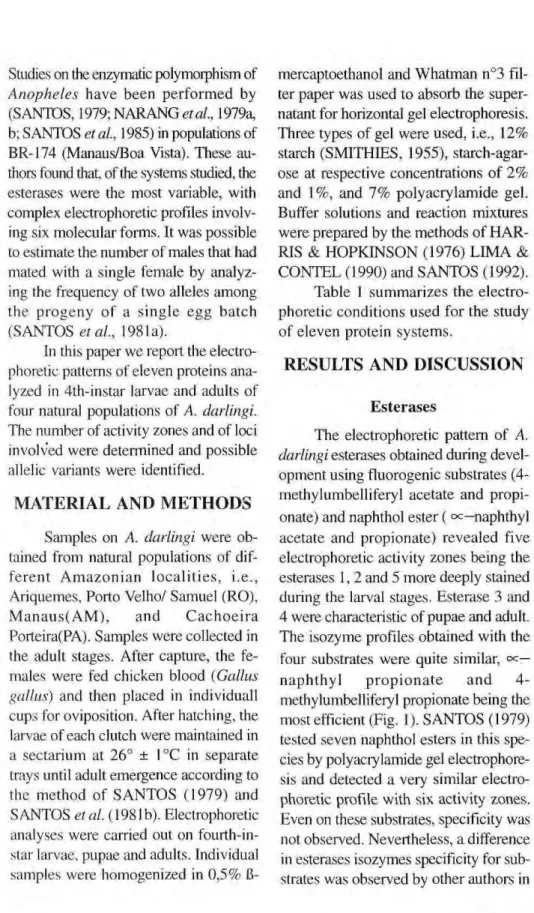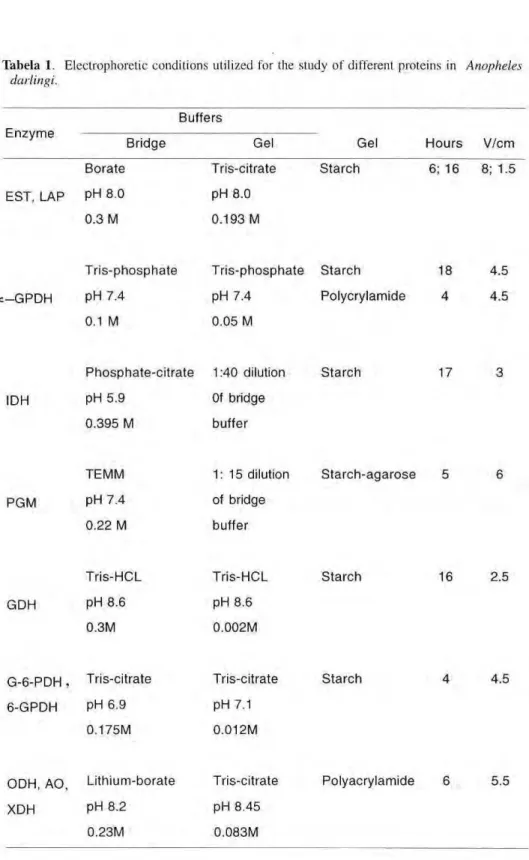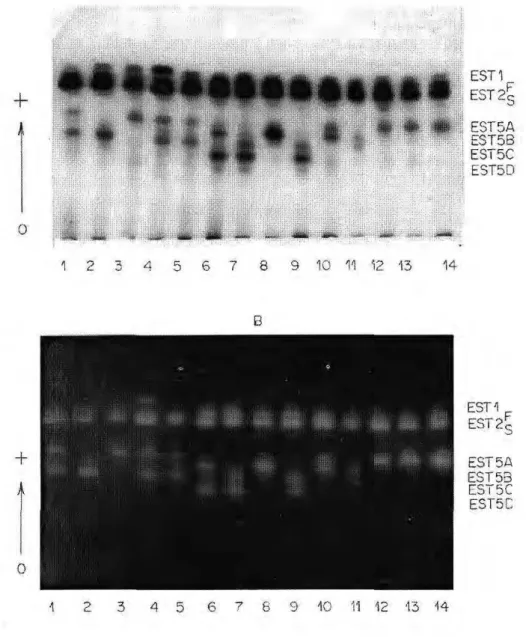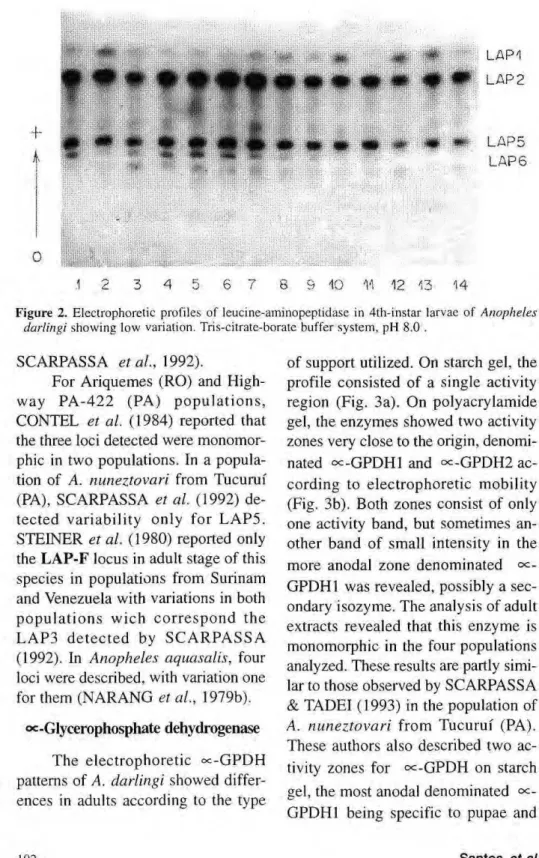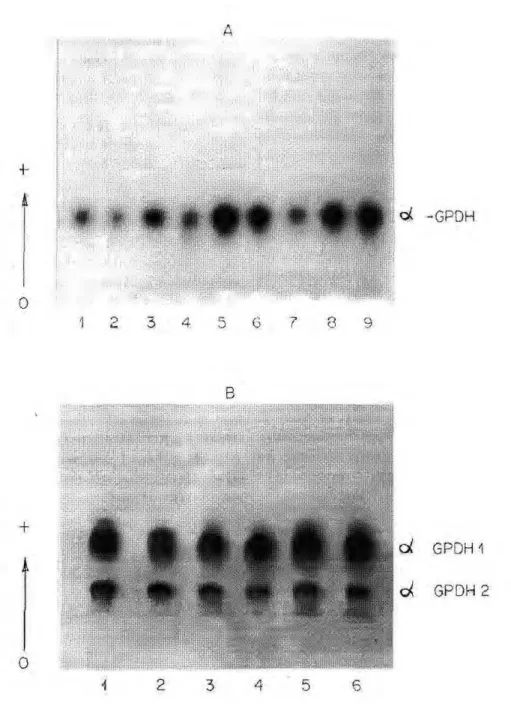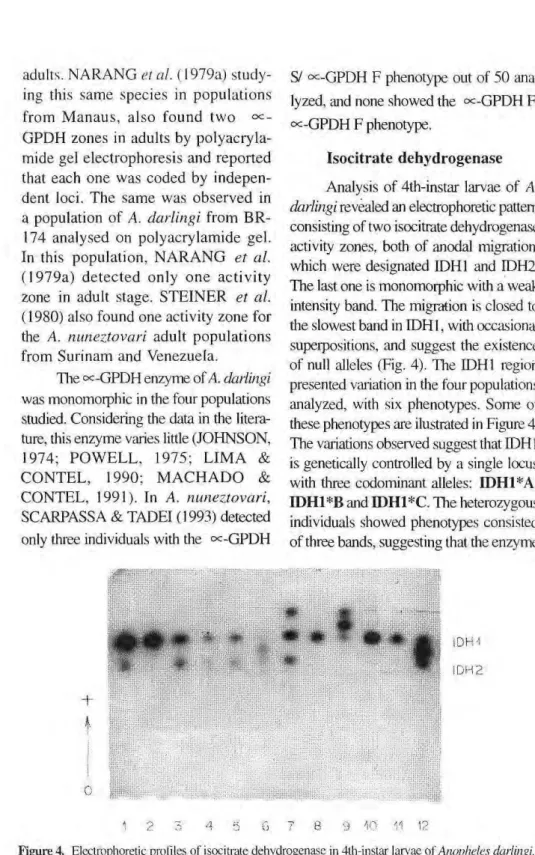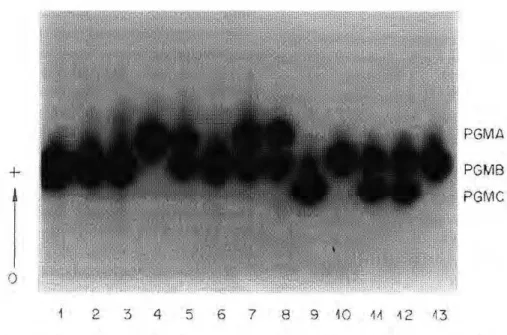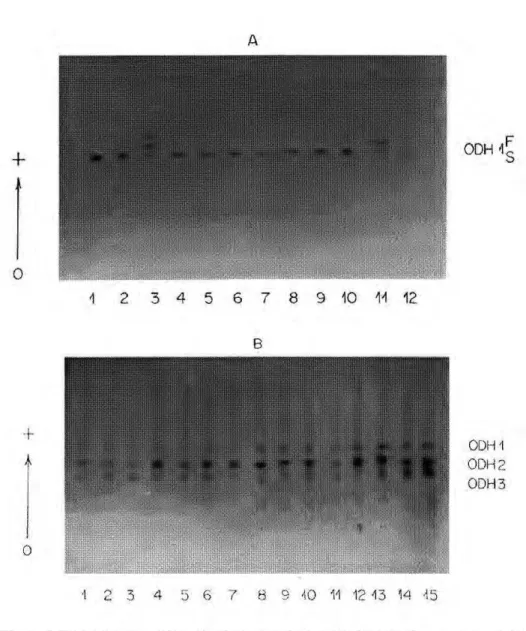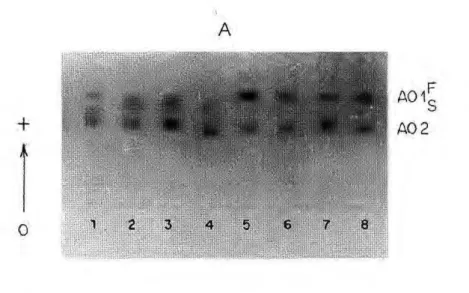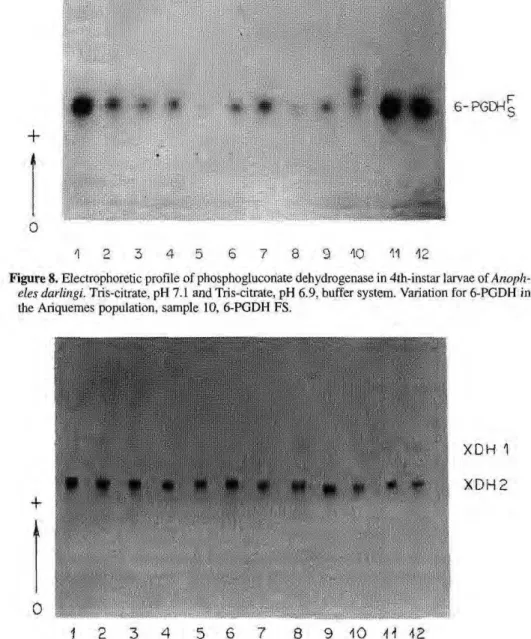ELECTROPHORETIC ANALYSIS OF 11 ENZYMES IN
NATURAL POPULATIONS
OF Anopheles (N.) darlingi
ROOT, 1926
(DIPTERA: CULICIDAE) IN THE AMAZON REGION.
Jaselita M.M. dos SANTOS1, Wanderli Pedro TADEP, Eucléia P.B. CONTEL3
ABSTRACT — Of eleven proteins analyzed in four Amazonian populations, the esterases showed the greatest variation, with five activity zones. EST1, EST2 and EST5 showed variation in each of the populations studied. EST1 and EST2 are each controlled by two, and EST5 by four, codomi-nant alleles. LAP presented six activity zones, with codomicodomi-nant variation in LAP5 and LAP6.
oc—GPDH was monomorphic with one activity band on starch gel and two on polyacrylamide gel. 1DH presented two activity zones, with variation in the IDHl region. PGM had a single activity zone, with variation in all populations. The Ariquemes populations showed five alleles and the other populations three, all of then codominant. Three activity zones with two codomi-nant alleles were observed for ODH. Aldehyde Oxidase showed two activity zones, with varia-tion in AOl only in the Ariquemes and Porto Velho/Samuel populavaria-tions. 6-PGDH showed only one activity zone and variation only in the Ariquemes population. The remaing systems - XDH, G-6-PDH and GDH. was m o n o m o r p h i c .
Key words: Anopheles darlingi, isozymes, electrophoresis
Análise Eletroforética de 11 Enzimas era Populações Naturais de Anopheles (Ν.) darlingi Root, 1926 (Diptera: Cuiicidae) na Região Amazônica.
RESUMO — Dos 11 sistemas protéicos analisados, em quatro populações da Amazônia, as es-terases foram as que apresentaram maior variação, com cinco zonas de atividade. EST1, EST2, e EST5 mostraram variação genética determinada em todas populações estudadas, sendo que as duas primeiras são resultantes do controle de dois alelos e a EST5 de quatro, todos codominantes. A LAP consiste de seis zonas de atividade e com variação apenas nos loci LAP5 e LAP6, ambos codominantes. A GPDH mostrou-se monomórfica com uma zona de atividade em gel de amido e duas em poliacrilamida. A IDH apresentou duas zonas de atividade, com variação na região da IDH1. A PGM consiste de uma única zona de atividade e com variação em todas as populações estudadas. A população de Ariquemes revelou cinco alelos e as demais três, todos codominantes. Para a ODH, foram observadas três zonas de atividade com dois alelos codominantes. A enzima AO apresentou duas zonas de atividade, sendo que a AOl mostrou-se variável apenas em Ariquemes e Porto Velho/Samuel. 6-PGDH possui apenas uma zona de atividade e variação apenas em Ariquemes. Os demais sistemas - XDH, G-6-PDH e GDH - mostraram-se monomórficos.
Palavras-chave: Anopheles darlingi, isoenzimas, eletroforese
INTRODUCTION
Studies on the protein variability of Anopheles have shown that in this group of mosquitoes, most isoenzymatic patterns are of autosomal codominant inheritance
(BIANCHI & RINALDI, 1970; BOLLINI
et al., 1971a; N A R A N G & KITZMILLER, 197la, b; 1973a, b; NARANG & SEAWRIGHT, 1988; KAI-SER etai, 1988; NARANG etal, 1979a, b; 1989a, b; 1990; SANTOS et al., 1992).
1 Instituto Nacional de Pesquisas da Amazônia-INPA, Cx. Postal 478, CEP: 69011 -470 - Manaus(AM),
Brasil.
2 Instituto Nacional de Pesquisas da Amazônia/UNESP
3 Depart. de Genética, Faculdade de Medicina, 14049-900 Ribeirão Preto(SP).
Studies on the enzymatic polymoiphism of
Anopheles have been performed by
(SANTOS, 1979; NARANG et ai, 1979a, b; SANTOS et ai, 1985) in populations of BR-174 (Manaus/Boa Vista). These au-thors found that, of the systems studied, the esterases were the most variable, with complex electrophoretic profiles involv-ing six molecular forms. It was possible to estimate the number of males that had mated with a single female by analyz-ing the frequency of two alleles among the progeny of a single egg batch (SANTOS et ai, 1981a).
In this paper we report the electro-phoretic patterns of eleven proteins ana-lyzed in 4th-instar larvae and adults of four natural populations of A. darlingi.
The number of activity zones and of loci involved were determined and possible allelic variants were identified.
M A T E R I A L A N D M E T H O D S
Samples on A. darlingi were ob-tained from natural populations of dif-ferent Amazonian localities, i.e., Ariquemes, Porto Velho/ Samuel (RO), Manaus(AM), and Cachoeira Porteira(PA). Samples were collected in the adult stages. After capture, the fe-males were fed chicken blood (Gallus
gallus) and then placed in individuali
cups for oviposition. After hatching, the larvae of each clutch were maintained in a sectarium at 26° ± l°C in separate trays until adult emergence according to the method of SANTOS (1979) and SANTOS et al. ( 1981 b). Electrophoretic analyses were carried out on fourth-in-star larvae, pupae and adults. Individual samples were homogenized in 0,5%
β-mercaptoethanol and Whatman n°3 fil-ter paper was used to absorb the super-natant for horizontal gel electrophoresis. Three types of gel were used, i.e., 12% starch (SMITHIES, 1955), starch-agar-ose at respective concentrations of 2% and 1%, and 7% poly aery lamide gel. Buffer solutions and reaction mixtures were prepared by the methods of HAR-RIS & HOPKINSON (1976) LIMA & CONTEL (1990) and SANTOS (1992).
Table 1 summarizes the electro-phoretic conditions used for the study of eleven protein systems.
R E S U L T S A N D D I S C U S S I O N
Esterases
The electrophoretic pattern of A.
darlingi esterases obtained during
devel-opment using fluorogenic substrates (4-methylumbelliferyl acetate and propi-onate) and naphthol ester ( oc—naphthyl
acetate and propionate) revealed five electrophoretic activity zones being the esterases 1,2 and 5 more deeply stained during the larval stages. Esterase 3 and 4 were characteristic of pupae and adult. The isozyme profiles obtained with the four substrates were quite similar, cc—
Tabela I. Electrophoretic conditions utilized for the study of different proteins in Anopheles darlingi.
Buffers E n z y m e
Bridge Gel Gel H o u r s V/cm
Borate Tris-citrate S t a r c h 6; 16 8; 1.5
EST, LAP PH 8.0 pH 8.0 0.3 Μ 0.193 Μ
: - G P D H
T r i s - p h o s p h a t e
pH 7.4
0.1 Μ
T r i s - p h o s p h a t e S t a r c h
pH 7.4
0.05 Μ
Polycrylamide
4.5
4.5
IDH
P h o s p h a t e - c i t r a t e 1:40 dilution
pH 5.9
0.395 Μ
Of bridge
buffer
S t a r c h 17
PGM
TEMM
pH 7.4
0.22 Μ
1 : 1 5 dilution
of bridge
buffer
Starchagarose
GDH
Tris-HCL
pH 8.6
0.3M
Tris-HCL
pH 8.6
0.002M
S t a r c h 16 2.5
G - 6 - P D H , Tris-citrate
6-GPDH PH 6.9
0.175M
Tris-citrate
pH 7.1
0.012M
Starch 4.5
ODH, AO Lithium-borate Tris-citrate
XDH PH 8.2 pH 8.45
0.23M 0.083M
E 5 T 5 A EST5B EST5C EST5D
1 2 3 4 5 6 7 9 10 11 12 13 14
+
À
EST1 EST 2 S
EST5A EST 5 3 EST5C EST5C
1 2 3 4 5 6 7 8 9 13 14
insects and other organisms, TREBATOSKI & HAYNES (1969) ob-served this difference in twelve species of mosquitoes, HOPKINSON et al. (1973) and CO ATES et al. (1975) in human erythrocytes, FALCÃO & CONTEL (1990) in species of stingless bees, and LIMA & CONTEL (1990) in Spodoptera frugiperda.
Of the five isozymes detected, EST1, EST2 and EST5 showed varia-tion in four populavaria-tions analyzed. The electrophoretic phenotypes observed for EST1 and EST2 suggest that each is genetically controlled by a locus with two codominant alleles (EST1*F
and EST1*S, EST2*F and EST2*S).
The heterozygous individuals pre-sented two bands for the two loci, sug-gesting that these enzymes have a monomeric structure.
Similar results were observed for
the EST1, EST2 and EST4 loci of
Anopheles triannulatus (SANTOS et ai, 1992), EST1 and EST2 of Anoph-eles nuneztovari (SCARPASSA, 1988)
and EST2 of the A. darlingi
popula-tion along the Manaus - Boa Vista Highway/BR-174 (SANTOS et ai,
1985) when the authors reported a genetic mechanism for each locus con-stituted by two codominant alleles.
The electrophoretic profiles for EST5 showed variation in the popu-lation studies with ten phenotypes. Of these possible phenotypes, EST5 C, EST5 CD and EST5 D were not de-tected in the Manaus population. Analysis of the data suggests that
lo-cus EST5 has four alleles - EST5*A,
EST5*R, EST5*C and EST5*D - of
codominant action. The pattern of two
bands observed in the heterozygotes suggests that EST5 presents a mono-meric structure. A similar mechanism was found in the EST3 and EST5 loci
of A. triannulatus (SANTOS et al, 1992) and in the EST6 locus of A.
nuneztovari (SCARPASSA, 1988). The authors detected six phenotypes for these loci resulting from the action of three codominant alleles.
Leucine aminopeptidase
Leucine aminopeptidase consisted of six activity zones present during the life cycle of A. darlingi. The figure 2 shows LAPI, LAP2, LAP5 and LAP6, detected in 4th-instar larvae. LAP3 was especific for pupae and adults, LAP4 was detected only
in pupae. Of the six bands detected, only LAP5 and LAP6 presented variations. In spite of difficulties in the interpretation of their phenotypes, the data suggest that loci
LAP5 and LAP6 possess two codominant
alleles each, denoted LAP5*F, LAP5*S, LAP6*F and LAP6*S, respectively. The two bands in the LAP5 and LAP6 forms may be interpreted as indicating heterozy-gous phenotypes for monomeric proteins.
Of the four populations in which the LAP system was studied, the Manaus population showed apparent monomor-phism for the six loci analyzed. However, the data obtained were not sufficiently con-clusive because of the small number of samples for this population.
Low variation was found in A. darlingi for this enzyme, in agreement with data in the literature for the ma-jority of Anopheles species of the sub-genus Nyssorhynchus (NARANG et ai, 1979a, 1979b; STEINER et ai,
Η™
•ΜL A P 1
L A P 2
p L A P 5 L A P 6
Ο
3 4 6 7 8 9 40 12 13
Figure 2. Electrophoretic profiles of leucine-aminopeptidase in 4th-instar larvae of Anopheles darlingi showing low variation. Tris-citrate-borate buffer system, pH 8.0 .
SCARPASSA et al., 1992).
For Ariquemes (RO) and High-way PA-422 (PA) populations, CONTEL et al. (1984) reported that the three loci detected were monomor-phic in two populations. In a popula-tion of A. nuneztovari from Tucurui (PA), SCARPASSA et al. (1992) de-tected variability only for LAP5. STEINER et al. (1980) reported only
the LAP-F locus in adult stage of this
species in populations from Surinam and Venezuela with variations in both populations wich correspond the LAP3 detected by SCARPASSA (1992). In Anopheles aquasalis, four loci were described, with variation one for them (NARANG et ai, 1979b).
©^-Glycerophosphate dehydrogenase
The electrophoretic °c-GPDH patterns of A. darlingi showed differ-ences in adults according to the type
A
adults. NARANG era!. (1979a) study-ing this same species in populations from Manaus, also found two «=-GPDH zones in adults by polyacryla-mide gel electrophoresis and reported that each one was coded by indepen-dent loci. The same was observed in a population of A. darlingi from
BR-174 analysed on polyacrylamide gel. In this population, NARANG et al. (1979a) detected only one activity zone in adult stage. STEINER et al. (1980) also found one activity zone for the A. nuneztovari adult populations from Surinam and Venezuela.
The oc-GPDH enzyme of A. darlingi was monomorphic in the four populations studied. Considering the data in the litera-ture, this enzyme varies little (JOHNSON, 1974; POWELL, 1975; LIMA & CONTEL, 1990; MACHADO & CONTEL, 1991). In A. nuneztovari, SCARPASSA & TADEI (1993) detected only three individuals with the ©c-GPDH
S/ oc-GPDH F phenotype out of 50 ana-lyzed, and none showed the °c-GPDH F/ oc-GPDHF phenotype.
Isocitrate dehydrogenase
Analysis of 4th-instar larvae of A. darlingi revealed an electrophoretic pattern consisting of two isocitrate dehydrogenase activity zones, both of anodal migration, which were designated IDH1 and IDH2. The last one is monomorphic with a weak intensity band. The migration is closed to the slowest band in IDH1, with occasional superpositions, and suggest the existence of null alleles (Fig. 4). The IDH1 region presented variation in the four populations analyzed, with six phenotypes. Some of these phenotypes are ilustrated in Figure 4. The variations observed suggest that IDH1 is genetically controlled by a single locus with three codominant alleles: Π)Η1*Α, IDH1*B and IDH1*C. The heterozygous individuals showed phenotypes consisted of three bands, suggesting that the enzyme
mm
1DH2
Figure 4. Electrophoretic profiles of isocitrate dehydrogenase in 4th-instar larvae of Anopheles darlingi.
may be dimeric.
In the analysis of the Porto Velho/ Samuel population, the presence of al-lele Π)Η1*Α was not detected. In the
Cachoeira Porteira and Manaus popula-tions the IDH1 A and IDH1 C pheno-types were not detected, whereas in Ariquemes only phenotype IDH1 A was not observed. Similar results were found in populations of Anopheles stephensi from Pakistan by VAN DRIEL et al. (1987) when 11 progenies were ana-lyzed and the allele IDH1*A was not detected in four of them. The IDH2 re-gion was monomorphic in all popula-tions studied and consisted of only one weakly staining band located very close to the slowest IDH1 band. Analysis of these two regions was also hampered by occasional overlapping.
These results disagree, in part, with those obtained by ROSA-FREITAS et al. (1992) for three A. darlingi populations, the authors re-ported three alleles for the IDH2 locus, two of them having low frequencies (0.0455 and 0.1591).
Phenotypic variants of IDH1 and IDH2 have been observed in the popu-lations of A. nuneztovari from BR-174 (SCARPASSA, personal communica-tion) and from Manaus for the IDH2
locus (NARANG et al. 1979a).
Phosphoglucomutase
The electrophoretic pattern de-tected for phosphoglucomutase in 4th-instar larvae of A. darlingi consisted of a single activity zone of anodal migra-tion. In the population analysis, PGM revealed phenotypic variants differing
among the population studied. The data suggest that these phenotypes are geneti-cally controlled by one locus with five codominant alleles: PGM*A, PGM*B,
PGM*C, PGM*A1 and PGM*B1 Of
the possible phenotypes resulting from the combination of the alleles, we did not detect PGM A l , PGM A IB, PGM A1C or PGM B1C. Heterozygous in-dividuals presented two bands of equal staining intensity. Only the
PGM*A and PGM*B alleles were
detected in Ariquemes. The other populations showed similar electro-phoretic patterns with six phenotypes resulting from the control of three al-leles, PGM*A, PGM*B and PGM*C
(Fig. 5). These data are in accordance with those obtained BULLINI et al. (1971b, 1971c) in A. stephensi and CHARLWOOD et al. (1985) in Anopheles punctulatus Donitz, who also detected one activity band with polymorphism consisting of three leles for the first species and four al-leles for the second. ROSA-FREITAS et al. (1992) studied PGM in one popu-lation of A darlingi from the Amazon re-gion and two from the South of Brazil and detected four alleles, three of them segre-gating in each population.
Octanol dehydrogenase
1 2 3 4 5 6 7 8 9 10 U 12 Ί 3
Figure 5. Electrophoretic profiles of phosphoglucomutase in 4th-instar larvae of Anopheles darlingi.
TEMM buffer system, pH 7.4 . Electrophoretic phenotypes of PGM in the Manaus population. Sample 4, PGM A; samples 5,7 and 8, PGM AB; samples 1,2, 3, 6, 10 and 13, PGM B; samples 11 and 12, PGM BC; sample 9, PGM C.
phenotypic variants detected for ODH1 may be determined by two codominant alleles at the ODH1 locus, ODHl*F and
O D H l*S. In the population from
Cachoeira Porteira, only individuals show-ing the ODH1 S phenotype were detected (Fig. 6b). The observation of the pheno-types suggest the existence of a null allele
- 0 D H 1 * 0 . The null allele was not
de-tected in the population from Manaus.
The ODH2 locus showed
variabil-ity in all populations and notwithstand-ing difficulties in the interpretation of their phenotypes, the data suggest that there exist three alleles - ODH2*F, ODH2*S and ODH2*0.
Locus ODH3 showed variability in all populations except that from Manaus. The phenotypic variation de-tected suggests that this locus has three alleles: ODH3*F, ODH3*S and
ODH3*0. Similar data were observed
by NARANG et al. (1979a) in a popu-lation of A. darlingi from BR-174 (Manaus/Boa Vista) and in a population of A. nuneztovari from Manaus. In both species, the authors reported three actvity zones. In the first population, polymorphism was only detected at the
ODH2 locus, whereas in the second,
polymorphism was detected only at the
ODH1 locus. At both loci, these authors
detected three codominant alleles. In A. aqimsalis, NARANG et al. (1979b) also reported three ODH loci, but all were
monomorphic. In the A. darlingi popu-lations studied here, the ODH1 locus
from the Cachoeira Porteira population and the ODH3 locus from Manaus were
Β
1 2 3 4 5 6 7 8 9 40 11 12 13 14 45
the electrophoretic profile of ODH con-sisted of only one activity band with three phenotypes controlled by two codominant alleles. Similar results were found in Anopheles culicifacies by AHMAD et al. (1978).
Aldehyde oxidase
Aldehyde oxidase consisted of two main activity zones: AOl and A02. A third zone was detected in the Ariquemes and Cachoeira Porteira populations, but it was not considered in the populations studied.
AOl showed variability only in Ariquemes and Porto Velho/Samuel, and consisted of three phenotypes. The phenotypic variants detected suggest that this locus may have two codomi-nant alleles, A 0 1* F and A 0 1 * S , with
heterozygous individuals showing three bands suggesting a dimeric structure (Fig. 7a). Null alleles were also detected at this locus. Analysis of the Cachoeira Porteira and Manaus populations did not show variations for the A O l locus, but only the
A 0 1* F allele was observed (Fig. 7b). A02 showed variations in all popu-lations analyzed, with a pattern consisting of two or three bands in the heterozygotes, which may be interpreted as secondary changes, i.e., post-translational changes. Analysis of these phenotypes suggests that the genetic control of this enzyme occurs through two codominant alleles - A02*F
and A02*S. A similar pattern was ob-served in a population of A. darlingi from BR-174 (Manaus/Boa Vista) and a popu-lation of A. nuneztovari from Manaus (NARANG et ai, 1979a). In both species, the authors reported three activity zones,
with variations, in which the most anodic (AOl) had low activity, which was visu-alized only after a prolonged time. In A. darlingi studied here, it was the A 0 3 zone that presented low activity and that was not visualized in most analyses.
6-Phosphogluconate dehydrogenase
A single activity zone of phosphogluconate dehydrogenase was de-tected (Fig. 8). Variation for this enzyme was found only in the Ariquemes popula-tion. The phenotypes observed suggest the existence of two alleles: 6-PGDH*F and
6-PGDH*S. The populations from Porto
Velho/Samuel, Cachoeira Porteira and Manaus were monomorphic.
The data of variation in heterozy-gotes showed three bands, indicating that this protein has a dimeric structure, the same as that reported by CHENG & HACKER (1976) in Culex p.
quinquefasciatus. SCARPASSA (personal
communication) detected three alleles for the 6-PGDH locus with segregation
for only two in each population of A.
nuneztovari from amazon region.
Xanthine dehydrogenase
A
Figure 7. Electrophoretic profiles of aldehyde oxidase in 4th-instar larvae of Anopheles darlingi.
o
1 6 7 11 12
Figure 8. Electrophoretic profile of phosphoglucoriate dehydrogenase in 4th-instar larvae of Anoph-eles darlingi. Tris-citrate, pH 7.1 and Tris-citrate, pH 6.9, buffer system. Variation for 6-PGDH in the Ariquemes population, sample 10, 6-PGDH FS.
X D H 1
X D H 2
0
9 1 0 ÍÍ 4 2
for the A. darlingi population from BR-174. These authors detected three activity zones without variation, in which only the XDH2 zone was con-sidered, since X D H 1 and X D H 3 showed low activity.
The other systems analyzed in the present study - glucose dehydrogenase and glucose-6-phosphate dehydrogenase - re-vealed only one activity band, without variations in the populations.
A C K N O W L E D G M E N T S
T h e authors are grateful to Juracy de Freitas Maia for technical assistance. This research was sup-ported in part by POLONOROESTE/ CNPq/ELETRONORTR
L I T E R A T U R E C I T E D
AHMAD, M.; SAKAI, R.K.; BAKER, R.H.; AINSLEY, R.W. 1978. Genetic analysis of two enzyme polymorphisms in a malaria vector mosquito. J. Hered, 69:155-158. BIANCHI, V.; RINALDI, A. 1970. New Gene
enzyme system in Anopheles atroparvus.
Ocurrence and frequencies of four alleles at the EST6 locus. Can. J. Genet. Cytol,
12:233-330.
BULLINI, L., COLUZZI, M.; BULLINI, A.P.; BIANCHI, U.; BLEINER, G. 1971a. Phosphoglucomutase polymorphism in
Culex pipiens (Diptera:Culicidae).
Parasitologia, 13:349-443.
BULLINI, L.; CANCRINI, G.; BULLINI, A.P.; BIANCHI, U.; DECO, M. 1971b. Further studies on the phophoglucomutase gene in
Anopheles stephensi: evidence for a fourth allele (Diptera:Culicidae). Parasitologia,
13:435-438.
BULLINI, L.; COLUZZI, M.; CANCRINI, G.; SANTOLAMAZZA, C. 1971c. Multiple phosphoglucomutase alleles in Anopheles stephensi. Heredity, 26:476-478. CHARLWOOD, J.D.; DAGORO, H.; PARU, R.
1985. Blood-infeeding and resting behaviour in the Anopheles punctulatus
Donitz complex (Diptera: Culicidae) from coastal Papua New Guinea. Bull, Ent. Res., 75:463-475.
CHENG, M.; HACKER, C.S. 1976. Intheritance of 6-phosphogluconate dehydrogenase
variants in Culex pipiens quinquefasciatus
Say. J. Hered., 67:215-219.
COATES, P.M.; M E S T R I N E R , M.A.; HOPKINSON, D.A. 1975. A preliminary genetic interpretation of the esterases isozymes of human tissues. Ann. Hum. Genet., 39:1-20.
CONTEL, E.P.B.; SANTOS, J.M.M.; TADEI, W.R 1984. Biologia de Anofelinos Amazônicos VI. Variabilidade enzimàtica em Anopheles darlingi Root (Diptera: Culicidae). Acta Amazônica, 14(1/2):238-243.
FALCÃO, T.M.M.A.; CONTEL, E.P.B. 1990. Genetic variability in natural popula-tions of Brazilian social bees. I. Isozyme patterns and polymorphism for esterases and total protein. Rev. Brasil. Genet.,
13(4):731-754.
H A R R I S , H.; H O P K I N S O N , D.A. 1976.
Handbook of enzyme electrophoresis in human genetics. North Holland. HOPKINSON, D.A.; MESTRINER, M.A.:
CORTNER, J. 1973. Esterase D: a new human p o l y m o r p h i s m . Ann. Hum. Genet., 37:119-137.
JOHNSON, G.B. 1974. Enzyme polymorphism and metabolism. Science, 184:28-37. KAISER, R E ; NARANG, S.K.; SEAWRIGHT,
J.A.; KLINE, D.L. 1988. A new member of the Anopheles quadrimaculatus com-plex, species C. J. Am. Mos. Control Assoc., 4 (4):494-499.
LIMA, L.M.K.S; CONTEL, E.P.B. 1990 - Elec-trophoretic analysis of 12 proteins in natu-ral populations of Spodoptera frugiperda
(Lepidoptera: Noctuidae). Rev. Brasil. Genet., 13 (4):711-729.
Biochem. Genet., 29 (5/6):255-260. NARANG, S.; KITZMILLER, J.B. 1971a.
Es-terase polymorphism in a natural popula-tion of Anopheles punctipennis. II. Analy-sis of the EST-C system. Can. J. Genet. CytoL, 13:771-776.
NARANG, S.; KITZMILLER, J.B. 1971b. De-hydrogenase polymorphism in Anopheles punctipennis (Diptera:Cuiicidae). Genet-ics of xanthine and octanol dehydrogena-ses. Ami. Ent. Soc. Am., 65 (4):798-804. NARANG, S.; KITZMILLER, J.B. 1973a.
Es-terase polymorphism in a natural popula-tion of Anopheles punctipennis. Genetic analysis of the esterase E system. Rev. Bras. Pesq. Med. Biol., 6 (6):361-365.
NARANG, S.; KITZMILLER, J.B. 1973b. Es-terase polymorphism in a natural popula-tion of Anopheles punctipennis. VI. Ge-netic analysis of the EST F system. Ciem. e Cult., 25 (11):1085-1088.
NARANG, S.; SANTOS, J.M.M.; GARCIA, J.C.; CRISTAKOU. H.D.; NARANG, N.
1979a. Genética de populações de anofelinos IV. Estudos eletroforéticos das populações naturais de Anopheles nuneztovari e Anopheles darlingi.
Correlação genética entre espécies. Acta Amazônica, 9(3):529-542.
N A R A N G , S.K.; KITZMILLER, J.B.; GALLER, R.; RIOS, I.R.; NARANG, N.
1979b. Genética de populações de anofelinos III. Análise eletroforética de
Anopheles aquasalis. Rev. Bras. Pes. Med. Biol., 12 (4/5):303-309.
NARANG, S.K.; SEAWRIGHT, J.A. 1988. Electrophoretic method for recognition of sibling species of anopheline mosqui-toes. A praticai approach. Proc. Symp. New Technologies for Taxonomic Iden-tification of de A r t h r o p o d s . Pia. Entomol, 71:303-311.
N A R A N G , S.K.; K A I S E R , P.E.; SEAWRIGHT, J.A. 1989a. Dichotomus electrophoretic taxonomic key for iden-tification of sibling species A, Β and C of the Anopheles quadrimaculatus com-plex (Diptera:Culicidae). J.Med.
Entomol., 26 (2):94-99.
N A R A N G , S.K.; T O N I O L O , S.R.; S E A W R I G H T , J.A.; K A I S E R , P.E. 1989b. Genetic differentiation among sibling s p e c i e s A, Β and C of the
Anopheles quadrimaculatus complex (Diptera:Culicidae). Ann. Ent. Soc. Am., 82 (4):508-515.
NARANG, S.K.; SEAWRIGHT, J.A.; KAISER, P.E. 1990. Evidence for microgeographic genetic subdivision of Anopheles quadrimaculatus species C. J. Am. Mosq. Control Assoc., 6 (2):179-187.
POWELL, J.R. 1975. Protein variation in natu-ral populations of animals. Evolutionary Biology, 18:79-119.
ROSA-FREITAS, M.G.; BROOMFIELD, G.; PRIESTMAN, Α.; MILLIGAN, P.J.M.; Μ OMEN, H.; MOLYNEUX, D.H. 1992. Cuticular hydrocarbons isoenzymes and behavior of three populations of Anoph-eles darlingi from Brazil. Mem. Inst. Oswaldo Cruz, 85 (3):275-289.
SANTOS, J.M.M. 1979. Aspectos biológicos e isoenzimálicos de Anopheles (Ν.) darlingi Root, 1926 (Diptera: Culicidae).
Dissertação de Mestrado, INPA/FUA, Manaus, Amazonas, 87 p.
SANTOS, J.M.M.; CONTEL, E.P.B.; KERR, W.E. 1981a. Biologia de Anofelinos Amazônicos. II. Fêmeas de Anopheles darlingi produzem filhos de um só macho.
Acta Amazônica, 11 (2):413-414. SANTOS, J.M.M.; CONTEL, E.P.B.; KERR,
W.E. 1981b. Biologia de Anofelinos Amazônicos 1 - Ciclo biológico, postura e estádios larvais de Anopheles darlingi
Root, 1926 (Diptera: Culicidae) da Rodovia Manaus/Boa Vista. Acta Amazônica, 11 (4):789-797.
SANTOS, J.M.M.; CONTEL, E.P.B.; KERR, W.E. 1985. Biology of amazonian mos-quitoes. III. Esterases i s o z y m e s in
Anopheles darlingi. Acta Amazônica,
15 (1/2):167-177.
de Doutoramento. INPA/FUA, Manaus, Amazonas, 150 p.
SANTOS, J.M.M.; TADEI, W.P.; CONTEL, E.RB. 1992. Biologia de Anofelinos Amazônicos XIV. Isoenzimas de esterase em Anopheles triannulatus (Neiva & Pinto, 1922). Acta Amazônica, 22(2):219-228.
SCARPASSA, V.M. 1988. Estudo do ciclo biològico e de isoenzimas na ontogênese de Anopheles (Nyssorhynchus) nuneztovari Gabaldon, 1940 (Diptera; Culicidae).
Dissertação de Mestrado, INPA/FUA, Manaus, Amazonas, 172 p.
SCARPASSA, V.M.; TADEI, W.P.; CONTEL, E.P.B. 1992. Biologia de Anofelinos Amazônicos. XV Leucina aminopeptidase em Anopheles (Nyssoríiynchus) nuneztovari:
ontogenia e variação genética. Acta Amazônica, 22 (2):229-238.
SCARPASSA, V.M.; TADEI, W.P 1993. Biology of Amazonian Anopheline. XIX. « -glycerophosphate dehydrogenase in Anoph-eles (Nyssorhynchus) nurteztovari: ontogeny and genetic variation. Rev. Brasil. Genet., 16 (2):297-306.
SMITHIES, O. 1955. Zone electrophoresis in starch gels: Group variation in the serum proteins of normal human adult.
Biochem. J., 61:629-641.
STEINER, W.W.M.; KITZMILLER, J.B.; OSTHERBUR, D.L. 1980. Gene differ-entiation in chromosome races of Anoph-eles nuneztovari (Gabaldon). Mosq. Syst., 12 (3):306-319.
TREBATOSKI, A.M.; HAYNES, J.F. 1969. Comparati on of enzymes of twelve species of mosquitoes. Ann. Entomol. Soc. Am., 62 (2):327-335.
VAN DRIEL, J.W.; SLUITERS, J.F.; VAN DER KAAY, H.J. 1987. Allozyme varia-tion in Anopheles stephensi Liston from Pakistan (Diptera: Culicidae). Biochem. Genet., 25 (11/12):789-802.
Aceito para publicação em 28.02.96
